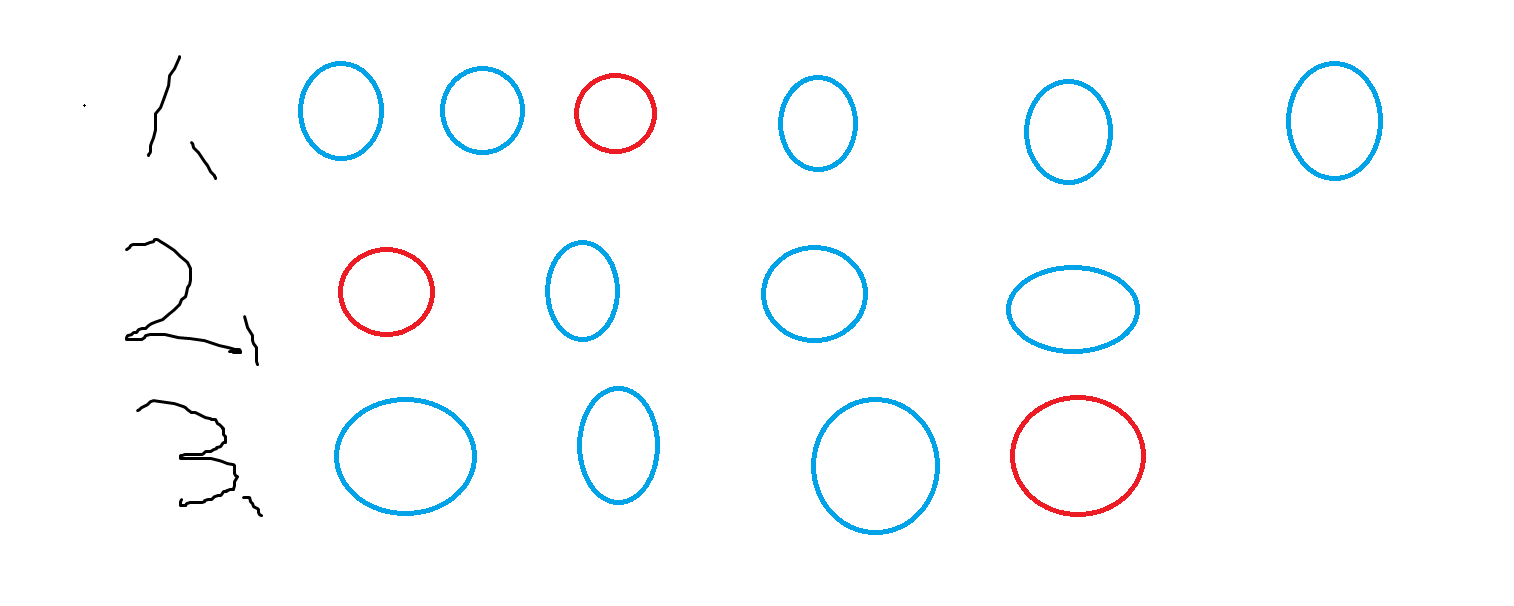P3509 [POI2010] ZAB-Frog 题解
题目链接:ZAB-Frog
基于一个根据距离第 \(k\) 大的事实:

容易知道,对于红色的点而言,与它相近最近的 \(k\) 个点是连续的。而第 \(k\) 远的要么是最左侧要么是最右侧。而我们注意到原数组是升序,那么考虑红色点往右走到新的位置,这些蓝色单点整天有什么影响:
左边的点离它更远了。
右边原本不属于第 \(k\) 远范围内的点离它更近了。
那么当移动以后会有这么个情况,最左边开始的部分蓝色点太远了,不如最右边的新出现的蓝色的点。那么显然可以看做整体蓝色连续段往右移动了。更一般来说,将当前点与离它最近的 \(k\) 个点,放在一个窗口里,显然是连续的,而随着这个点往右移动,窗口也会往右移动,窗口大小为 \(k+1\)。那么这个窗口移动规则也很简单,新的最右边的点比最左边的点更近,就需要移除这个最左边的点,加入新的最右边的点。也就是每个点的第一次移动是很好处理出来的,滑窗处理完以后,判断左右端点谁更远就是谁是第 \(k\) 远。
考虑走 \(m\) 步,\(m\) 特别大,知道每个点走一步的情况,直接倍增预处理就能知道走 \(m\) 步的情况了。
参照代码
#include <bits/stdc++.h>
// #pragma GCC optimize("Ofast,unroll-loops")
// #pragma GCC optimize(2)
#define isPbdsFile
#ifdef isPbdsFile
#include <bits/extc++.h>
#else
#include <ext/pb_ds/priority_queue.hpp>
#include <ext/pb_ds/hash_policy.hpp>
#include <ext/pb_ds/tree_policy.hpp>
#include <ext/pb_ds/trie_policy.hpp>
#include <ext/pb_ds/tag_and_trait.hpp>
#include <ext/pb_ds/hash_policy.hpp>
#include <ext/pb_ds/list_update_policy.hpp>
#include <ext/pb_ds/assoc_container.hpp>
#include <ext/pb_ds/exception.hpp>
#include <ext/rope>
#endif
using namespace std;
using namespace __gnu_cxx;
using namespace __gnu_pbds;
typedef long long ll;
typedef long double ld;
typedef pair<int, int> pii;
typedef pair<ll, ll> pll;
typedef tuple<int, int, int> tii;
typedef tuple<ll, ll, ll> tll;
typedef unsigned int ui;
typedef unsigned long long ull;
typedef __int128 i128;
#define hash1 unordered_map
#define hash2 gp_hash_table
#define hash3 cc_hash_table
#define stdHeap std::priority_queue
#define pbdsHeap __gnu_pbds::priority_queue
#define sortArr(a, n) sort(a+1,a+n+1)
#define all(v) v.begin(),v.end()
#define yes cout<<"YES"
#define no cout<<"NO"
#define Spider ios_base::sync_with_stdio(false);cin.tie(nullptr);cout.tie(nullptr);
#define MyFile freopen("..\\input.txt", "r", stdin),freopen("..\\output.txt", "w", stdout);
#define forn(i, a, b) for(int i = a; i <= b; i++)
#define forv(i, a, b) for(int i=a;i>=b;i--)
#define ls(x) (x<<1)
#define rs(x) (x<<1|1)
#define endl '\n'
//用于Miller-Rabin
[[maybe_unused]] static int Prime_Number[13] = {0, 2, 3, 5, 7, 11, 13, 17, 19, 23, 29, 31, 37};
template <typename T>
int disc(T* a, int n)
{
return unique(a + 1, a + n + 1) - (a + 1);
}
template <typename T>
T lowBit(T x)
{
return x & -x;
}
template <typename T>
T Rand(T l, T r)
{
static mt19937 Rand(time(nullptr));
uniform_int_distribution<T> dis(l, r);
return dis(Rand);
}
template <typename T1, typename T2>
T1 modt(T1 a, T2 b)
{
return (a % b + b) % b;
}
template <typename T1, typename T2, typename T3>
T1 qPow(T1 a, T2 b, T3 c)
{
a %= c;
T1 ans = 1;
for (; b; b >>= 1, (a *= a) %= c)if (b & 1)(ans *= a) %= c;
return modt(ans, c);
}
template <typename T>
void read(T& x)
{
x = 0;
T sign = 1;
char ch = getchar();
while (!isdigit(ch))
{
if (ch == '-')sign = -1;
ch = getchar();
}
while (isdigit(ch))
{
x = (x << 3) + (x << 1) + (ch ^ 48);
ch = getchar();
}
x *= sign;
}
template <typename T, typename... U>
void read(T& x, U&... y)
{
read(x);
read(y...);
}
template <typename T>
void write(T x)
{
if (typeid(x) == typeid(char))return;
if (x < 0)x = -x, putchar('-');
if (x > 9)write(x / 10);
putchar(x % 10 ^ 48);
}
template <typename C, typename T, typename... U>
void write(C c, T x, U... y)
{
write(x), putchar(c);
write(c, y...);
}
template <typename T11, typename T22, typename T33>
struct T3
{
T11 one;
T22 tow;
T33 three;
bool operator<(const T3 other) const
{
if (one == other.one)
{
if (tow == other.tow)return three < other.three;
return tow < other.tow;
}
return one < other.one;
}
T3() { one = tow = three = 0; }
T3(T11 one, T22 tow, T33 three) : one(one), tow(tow), three(three)
{
}
};
template <typename T1, typename T2>
void uMax(T1& x, T2 y)
{
if (x < y)x = y;
}
template <typename T1, typename T2>
void uMin(T1& x, T2 y)
{
if (x > y)x = y;
}
constexpr int N = 1e6 + 10;
constexpr int T = 100;
int go[N][T];
ll a[N];
ll n, k, m;
inline void solve()
{
cin >> n >> k >> m;
forn(i, 1, n)cin >> a[i];
const int MX = log2(m);
int l = 1, r = k + 1;//包括当前点的k+1大小的滑窗
forn(i, 1, n)
{
while (r + 1 <= n and a[r + 1] - a[i] < a[i] - a[l])l++, r++;//新的点更优
go[i][0] = a[r] - a[i] > a[i] - a[l] ? r : l;//谁更远谁就是第k大,也即是第一次移动位置
}
forn(j, 1, MX)forn(i, 1, n)go[i][j] = go[go[i][j - 1]][j - 1];//倍增预处理
forn(i, 1, n)
{
int pos = i;
ll siz = m;
forv(i, MX, 0)if (siz >= 1ll << i)siz -= 1ll << i, pos = go[pos][i];//倍增查找
cout << pos << " ";
}
}
signed int main()
{
// MyFile
Spider
//------------------------------------------------------
// clock_t start = clock();
int test = 1;
// read(test);
// cin >> test;
forn(i, 1, test)solve();
// while (cin >> n, n)solve();
// while (cin >> test)solve();
// clock_t end = clock();
// cerr << "time = " << double(end - start) / CLOCKS_PER_SEC << "s" << endl;
}
\]
P3509 [POI2010] ZAB-Frog 题解的更多相关文章
- P3509 [POI2010]ZAB-Frog
题目描述 On the bed of one particularly long and straight Byteotian brook there lie rocks jutting above ...
- [洛谷P3509][POI2010]ZAB-Frog
题目大意:有$n$个点,每个点有一个距离(从小到大给出),从第$i$个点跳一次,会跳到距离第$i$个点第$k$远的点上(若有两个点都是第$k$远,就跳到编号小的上).问对于从每个点开始跳,跳$m$次, ...
- 2017-2018 ACM-ICPC Latin American Regional Programming Contest J - Jumping frog 题解(gcd)
题目链接 题目大意 一只青蛙在长度为N的字符串上跳跃,"R"可以跳上去,"P"不可以跳上去. 字符串是环形的,N-1和0相连. 青蛙的跳跃距离K的取值范围是[1 ...
- CF53C Little Frog 题解
Content 有一只小青蛙想游历 \(n\) 块土堆,它现在在 \(1\) 号土堆上,每次可以跳跃任意距离到达另外的一个土堆.它想让每次跳跃的距离都不相等,试找到这样的一个方案. 数据范围:\(1\ ...
- POI2010题解
POI2010题解 我也不知道我为什么就开始刷POI了 有些题目咕掉了所以不完整(我都不知道POI到底有多少题) [BZOJ2079][Poi2010]Guilds (貌似bz跟洛谷上的不是一个题?) ...
- bzoj2093: [Poi2010]Frog(单调队列,倍增)
2093: [Poi2010]Frog Time Limit: 10 Sec Memory Limit: 259 MBSubmit: 568 Solved: 186[Submit][Status] ...
- 洛谷P3502 [POI2010]CHO-Hamsters感想及题解(图论+字符串+矩阵加速$dp\&Floyd$)
洛谷P3502 [POI2010]CHO-Hamsters感想及题解(图论+字符串+矩阵加速\(dp\&Floyd\)) 标签:题解 阅读体验:https://zybuluo.com/Junl ...
- 【字符串】【hash】【倍增】洛谷 P3502 [POI2010]CHO-Hamsters 题解
这是一道字符串建模+图论的问题. 题目描述 Byteasar breeds hamsters. Each hamster has a unique name, consisting of lo ...
- 【题解】[LuoguP3503]「BZOJ2086」[POI2010] Blocks
题目描述 给出N个正整数a[1..N],再给出一个正整数k,现在可以进行如下操作:每次选择一个大于k的正整数a[i],将a[i]减去1,选择a[i-1]或a[i+1]中的一个加上1.经过一定次数的操作 ...
- BZOJ 2093: [Poi2010]Frog
Description 从一个点到达与他距离第 \(k\) 小的点,问从每个点跳 \(m\) 次到达那个点. Sol 队列+倍增. 保持队列里的元素个数为 \(k\) ,从前往后扫不难发现左右端点都是 ...
随机推荐
- var _ I = (*T)(nil)
学习的时候看到这样一行代码 var _ Codec = (*GobCodec)(nil) 查了一下后,得到该语句的作用为:检查GobCodec这个结构体是否实现了Codec这个接口 空白标识符_代表变 ...
- 新零售标杆 SKG 全面拥抱 Serverless,敏捷交付
副标题:SKG 渠道中台借助 SAE +大禹打造云原生 DevOPS,提效 60% 作者:陈列昂(SKG).昕辰.龙琛.黛忻 项目背景 未来穿戴健康科技股份有限公司(SKG)是一家专注为个人与家庭提供 ...
- es6-10
- 基于java+springboot的图书借阅网站-在线图书借阅管理系统
该系统是基于java+springboot开发的图书借阅管理系统.是给师弟开发的课程作业.大家学习过程中,遇到问题可以github咨询作者. 系统演示地址 前台 http://book.gitapp. ...
- Listener refused the connection with the following error: ORA-12514
1.问题 在使用Oracle SQL Developer时,遇到以下问题: 状态: 失败 -测试失败: Listener refused the connection with the followi ...
- 【Git】如何在github上提交PR(Pull Request)
[来源]https://mp.weixin.qq.com/s/yHQRjpVeZVV4PuoUKM0FSw
- Mybatis @Insert插入数据返回自增的主键id
mapper层 @Insert("insert into t_user (username,password,valid,create_time) values (#{username},# ...
- NodeJS安装指南(Mac)
nvm,node,npm之间的区别 nvm:nodejs 版本管理工具. 也就是说:一个 nvm 可以管理很多 node 版本和 npm 版本. nodejs:在项目开发时的所需要的代码库 npm:n ...
- 《OnJava》——11内部类
内部类 利用内部类,可以将逻辑上存在关联的类组织在一起,而且可以控制一个类在另一个类中的可见性. 内部类和组合不同,内部类是一种代码隐藏机制:将代码放在其他类的内部. 11.1 创建内部类 创建内部类 ...
- [转帖]Java 提速之 Large pages【译】
https://juejin.cn/post/7011002046899978253 一.前言 最近花了很多时间在 JVM 的内存预留代码上.它开始是因为我们得到了外部贡献,以支持在 Linux 上使 ...
